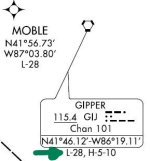manfredc3
SOH-CM-2022
Hello,
On one of the charts I pulled recently, it shows a L and H value under the VORTAC specs.
I have searched all over the place, and have not been able to find an explanation of the meaning of these indicators.

The VORTAC is showing on the KORD O'Hare EIGHT DEPARTURE chart.
Can anyone shine a light on this for me, please.
On one of the charts I pulled recently, it shows a L and H value under the VORTAC specs.
I have searched all over the place, and have not been able to find an explanation of the meaning of these indicators.
The VORTAC is showing on the KORD O'Hare EIGHT DEPARTURE chart.
Can anyone shine a light on this for me, please.

